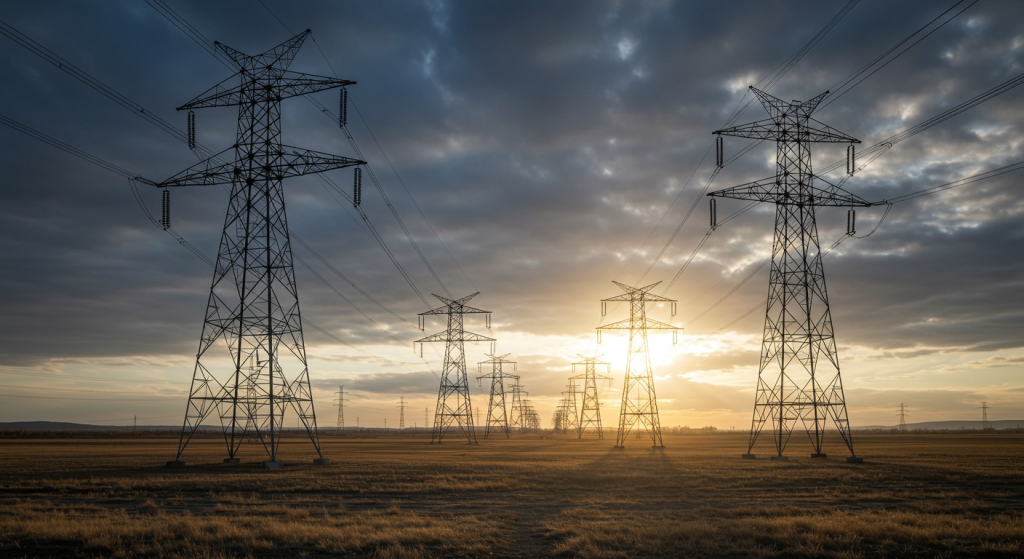Utility Power Towers: A Guide to Transmission Structures
2025-04-26
What are Utility Power Towers?
Utility power towers, also known as power transmission towers, high-voltage towers, and electricity pylons, are structures built to support high-power transmission lines. They are aimed at carrying high-voltage electrical conductors over immense distances, typically from generating plants to substations and finally to consumers via the power grid.
Key Features:
• Typical height 15 to 55 meters (50–180 feet)
• Voltage levels supported: 110 kV to 765 kV
• Galvanized lattice or tubular steel, aluminum, and other composite materials
Introduction to Utility Power Towers
A pole is defined as a tall, vertical structure of a framework that supports electric transmission lines, street lighting, and telecommunication aerials. In the case of utility power towers, polygonal cross-sectioned tubes are used to complete the poles, which ensure stability and durability for long-distance electricity transmission.
These structures are made from reinforced concrete, treated wood, or galvanized steel and are designed to withstand severe environmental conditions like strong winds, rain, and temperature changes. Their primary function is the mechanical support of power conductors and insulators with safety clearances of the electrical system.
Use of Utility Power Towers
Electric power Utility poles play a significant role in Craig systems, city grid networks, rural electrification activities, etc. Smart grids, telecommunication towers, and public lighting also incorporate the use of Utility poles.
Smart Grids
Smart grids mark a paradigm shift and innovation in electric Utility poles. Several grid features integrated with modern telecommunication technologies, monitoring mechanisms now allow the utility power to adjust and control in real time remotely.
Based on the application, poles have different heights, diameters, and designs for the power utility of poles. Utility power towers can be mounted as single stand-alone poles or can be put on high-voltage cylindrical or larger lattice structures.
Pole Design Parameters
The construction of utility power towers requires paying attention to the following characteristics:
• Material: Steel Q255B / Q355B / Q420B
• Wind Pressure: Resistance to 30M/S
• Surface Treatment: To hot-dip galvanize the surface to prevent corrosion.
• Voltage Grade: Accepts transmission from 10kV to 220kV
• Height: Customizable between 5 to 200 meters
• Tolerance: Calibrated to specific requirements about dimension tolerance

Types Available: Flange Type, Plug-in, and Reducing Poles
• Components: Pole body, cross arms, electric pole, climbing nails, and fall protection devices.
• Materials Used in Power Tower Construction
For the construction of utility power towers, the following materials are suggested. The efficiency and durability of power towers fundamentally rely on the materials used:
Galvanized Steel (Lattice Towers)
• Has a reasonable price without sacrificing quality.
• Toughest competition in terms of harsh weather and corrosion
Tubular Steel Casts
• Increased resistance to corrosion (and slightly more expensive than traditional)
• Parts are cheaper and less bulky to transport, lift, or install
• Lower visual impact for urban areas compared to the lattice structure.
Composites and Aluminium
• Increased lightness and high resistance to rusting
• Typically used in regions where speculative extremes wouldn't be defined.
How Utility Power Towers Work?
Power towers are more than just metallic structures that support and suspend tensioned power lines; they serve an integral role in electricity transmission as well.
Here’s how they function:
Generation: Power is generated at hydroelectric, thermal, solar, and nuclear power plants.
Step-Up Voltage: For electricity to be transmitted over large distances, transformers increase the voltage.
Transmission: Electricity is conducted through high-voltage, overhead power lines, which are supported by utility towers.
Step-Down Voltage: Substations lower the voltage for easier distribution.
Distribution: Powered electricity is sent to poles and underground lines for homes and businesses.
Power Tower Utility Engineering Design Considerations
Creating a power utility tower is a multifaceted problem. Each engineer has to pay attention to:
• Voltage/Current Load Capacity
• Wind and seismic activity susceptibility
• Height requirements
• Conductor sag and tension difference along the length
• The type of foundation and the soil of the region.
XYTOWER can simulate and analyze the performance of each of the tower's safety features using simulation and CAD tools. You can learn more about our design capabilities here.
Power Transmission Towers Construction
The construction of each power tower encompasses multiple phases:
- Conduct a topographical survey, then plan routes.
- Excavate and strengthen the base of the tower.
- A system of bolts and pre-fabricated sections is welded together on-site.
- The use of pulleys helps install high-tension wires.
- Conducting checks around the rotation to the ground, and alignment, sure of stability is thoroughly tested.
The complete method incorporates safety issues for employees, the impact on the ecosystem, and compliance with regional laws.
The Recent Advancements in The Technology Used in Power Towers
The utility power industry has not been left behind. We witness major power innovations such as:
- Smart towers equipped with IoT-based condition monitoring systems
- Robotic systems for maintenance and inspections
- Advanced composites for extremely cold weather
- AI-driven grid diagnostics
Utility power towers have today transformed from mere passive infrastructure and are becoming intelligent power towers with evolving functionalities and structural elements.
Why Use XY TOWER for Utility Power Towers?
At XY TOWER, we design, manufacture, and supply high-quality power transmission towers to suit the varying needs of modern energy networks.
What Makes Us Unique?
- Different quality certifications can be obtained for products, which guarantee their quality.
- We employ sophisticated technologies in numerous industrial and engineering applications.
- Administration of supply regions all over the world.
- It includes creating and modifying customer-specific products.
- Providing enduring and dependable answers to energy needs.
Conclusion
Utility power towers are more complex than their steel structure, resembling giants built next to highways and over hills. It is a critical part of energy systems that enable an economy to function, allow an industry to produce, and allow homes to be powered. These towers are destined to improve as smarter and greener energy systems are integrated with them, wherein they become more intelligent, stronger, and eco-friendly. When looking for reliable and creative solutions for power towers, do not hesitate to contact the employees of XY TOWER. We are prepared to assist you in powering the globe, one tower at a time.

Hey, I’m Chunjian Shu
"X.Y. Tower: Reliable, innovative solutions for high-quality towers and electrical equipment with professional service.
